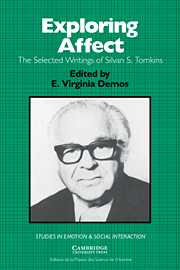Book contents
- Frontmatter
- Contents
- Foreword
- Editor's preface
- List of contributors
- Chronology
- Introduction
- Part I Affect theory
- Introduction
- Selections by Silvan S. Tomkins
- Part II Affect and ideology
- Introduction
- Selections by Silvan S. Tomkins
- Part III The face of affect
- Introduction
- Selections by Silvan S. Tomkins
- Part IV Script theory: The differential magnification of affect
- Introduction
- Selections by Silvan S. Tomkins
- Part V Human being theory: A foundation for the study of personality
- Introduction
- The larger context: Silvan Tomkins's human being theory
- Selections by Silvan S. Tomkins
- A complete annotated bibliography of Silvan S. Tomkins's writings
- References
- Author index
- Subject index
- Titles in the series
The larger context: Silvan Tomkins's human being theory
Published online by Cambridge University Press: 10 November 2010
- Frontmatter
- Contents
- Foreword
- Editor's preface
- List of contributors
- Chronology
- Introduction
- Part I Affect theory
- Introduction
- Selections by Silvan S. Tomkins
- Part II Affect and ideology
- Introduction
- Selections by Silvan S. Tomkins
- Part III The face of affect
- Introduction
- Selections by Silvan S. Tomkins
- Part IV Script theory: The differential magnification of affect
- Introduction
- Selections by Silvan S. Tomkins
- Part V Human being theory: A foundation for the study of personality
- Introduction
- The larger context: Silvan Tomkins's human being theory
- Selections by Silvan S. Tomkins
- A complete annotated bibliography of Silvan S. Tomkins's writings
- References
- Author index
- Subject index
- Titles in the series
Summary
Although Silvan Tomkins spent much of his professional life exploring human motivation, he never lost sight of his belief that the human being is embedded in a biopsychosocial matrix. This took him not only into areas such as ideology and history (selections on which can be found in Part II of this volume) but also into neurology and biology, for in order to fully understand the dynamics of personality, he felt he needed to have a comprehensive theory about human functioning. So he set to work formulating what he called human being theory.
He first presented these ideas in 1954 at an international congress in Montreal, where they were well received. They were first published in an expanded version in France in 1956 (see the Annotated Bibliography). Later, he presented them in a condensed version in chapter 1 of Volume 1 of Affect, Imagery, Consciousness (A.I.C.), published in 1962, and in a longer version, as chapter 1 of The Computer Simulation of Personality, a book he co-edited with S. Messick, published in 1963. We have reprinted some of this longer version here in Part V. Chapter 1 in A.I.C. was meant to introduce the larger enterprise in which he was engaged, which included not only affect but imagery and consciousness as well. He expected to elaborate on these last two aspects of his model after he had presented his ideas about affect.
- Type
- Chapter
- Information
- Exploring AffectThe Selected Writings of Silvan S Tomkins, pp. 415 - 422Publisher: Cambridge University PressPrint publication year: 1995
- 1
- Cited by



